It seems like ages ago that we chatted about my adventures with a linen that I was testing for possible use in constructing a tote bag with hand embroidered pockets.
The whole thing was a wash – I really abhorred the linen! – so I moved on to some cotton alternatives. I could have opted for better linen, no doubt, but since this whole project is somewhat experimental, I want to keep the cost point relatively low.
So I decided to try twill and duck.
Twill and Duck. I like those words together!
Here’s the whole idea for the project so far. I’ll tell you what I’m planning, we can chat about the two fabrics, and then I’ll keep you apprized of how things go on the stitching and, ultimately, on the construction & finishing of my Masterpiece Tote. Ha.
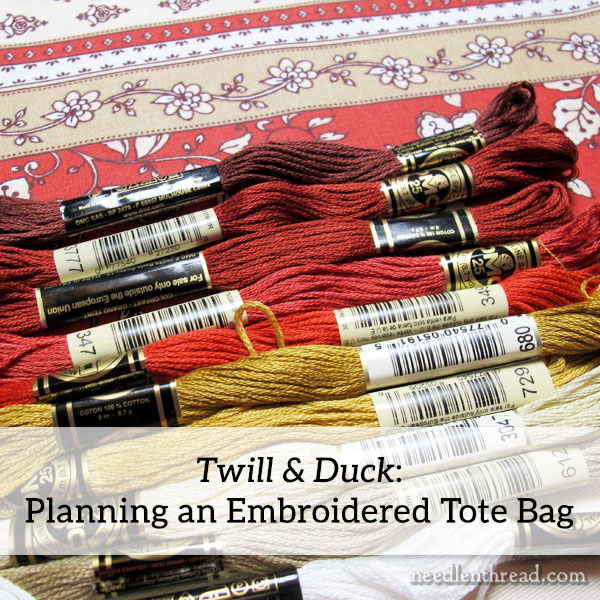
This is essentially the color conception for my embroidered tote idea, pulling the colors of embroidery floss based on the cotton lining fabric I plan to use for the bag.
My plan right now is to embroider at least one outside pocket for a tote. The bag itself will be predominantly a natural color with a red base and straps, with an embroidered pocket on one side of the outside of the tote (maybe on both sides, depending on how adventuresome I feel and how quickly the stitching goes!), with a cotton print for the inside lining.
When I initially started this project, I had planned on yellows and blues. Somehow, these morphed into reds and tans. That’s not to say I won’t go back to yellows and blues…. but for now, it’s reds and tans.
(I’m not sure how that happened!)
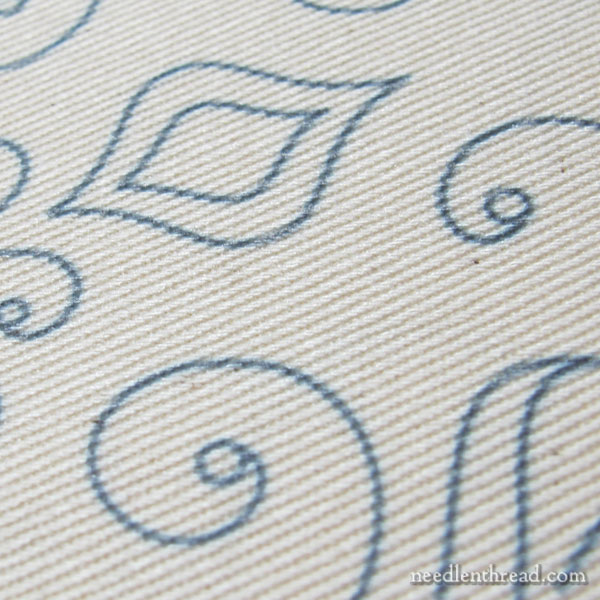
Meet Twill!
First, a bit about the fabrics.
For our purposes here, I’m talking about twill as a heavy-ish weight cotton fabric with a diagonal weave. Today, the most common twill fabric around the world is most likely denim – jeans are made from a twill weave fabric.
In the needlework world, the most common use for twill is in crewel embroidery, where linen twill is the typical historical ground fabric for crewel work. If you’ve done “real” crewel work, with wool on the traditional ground, most likely you were stitching on linen twill.
Twill is simply a type of weave. It looks, if examined closely, like a diagonally ribbed fabric, due to the sequence of weaving. It’s a very sturdy fabric, so it’s used often in the construction of work clothes and the like. Like most fabrics, it can come in different weights, though, but, when considering cotton twill especially, lighter weight twills are still a fairly heavy fabric.
Twill has a nice drape and a nice “hand.” This particular twill that I’m using is a more medium-weight twill. There are certainly heavier twills out there, but I liked the color (a natural color with a bit of speckle) and feel of this particular twill, so I went with it.
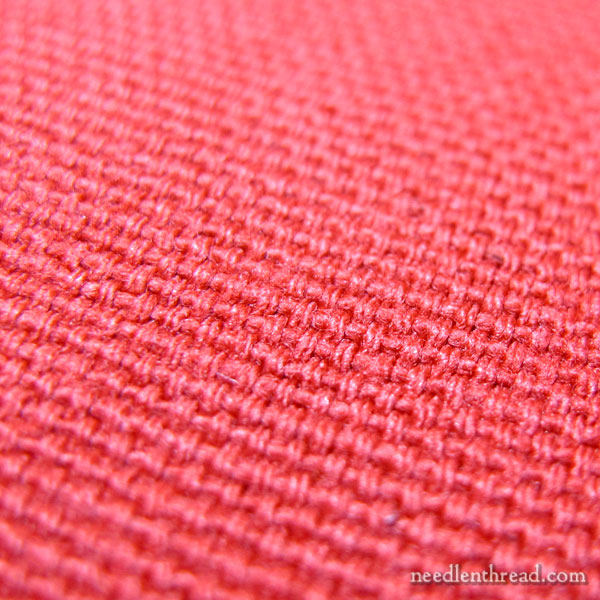
Meet Duck!
Hmmmm. Duck meat?
Duck is also a very sturdy cotton cloth, often used in the construction of outdoor textiles like awnings and whatnot, depending on the weight of the duck. It has a typical square weave (or plain weave). It’s favored not just for its sturdy construction, but for its availability in a wide range of colors.
Duck is often used interchangeably for “canvas” – you often hear the term “canvas duck” as a fabric. I think when people are talking about “canvas duck,” though, they generally mean the very heavy weight duck suitable for outdoor textiles. I think duck can be considered a type of canvas – canvas and duck are woven the same – but it’s usually a little lighter than canvas and it has a smoother hand. Canvas is more rugged and not quite as smooth.
Twill and duck are both heavy cotton fabrics, and really, the only important thing that distinguishes the two for my purposes is the weave. Twill has that diagonal, ribbed weave on close inspection, but duck is plain weave.
The twill I’m using is a little lighter weight than the duck, but neither are as heavy as they could be in their particular fabric categories.
How Do They Work for Hand Embroidery?
Neither twill nor duck are as easy to stitch through as a lighter weight linen or cotton that you might be accustomed to for needlework.
But they take embroidery well, like any natural fabric. There’s no real trick to working with either of them, except that they require a sharp needle. You’ll want to use a crewel (also called “embroidery”) needle or a chenille needle when embroidering on either fabric – definitely not a blunt tapestry needle!
Generally, neither twill nor duck require a lining fabric, as they’re both heavy fabrics and can pretty much support any density of stitching well.
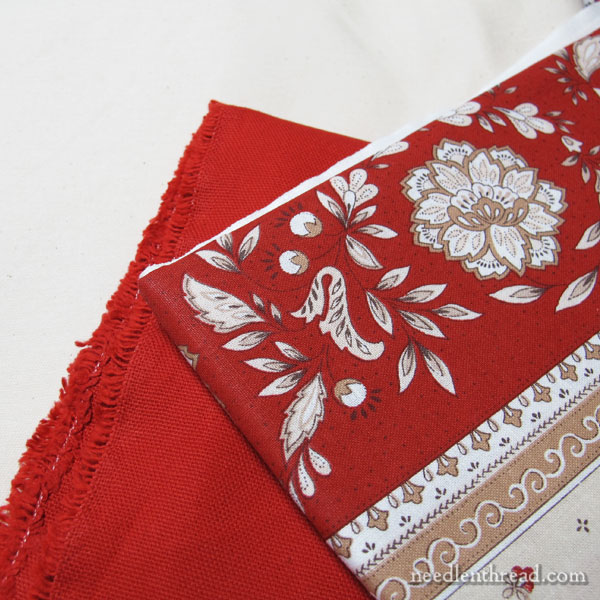
Preparing for Stitching
If you’re planning to launder the thing you’re making from the duck or twill, it’s pretty important to launder the fabric before embroidering it. Cotton shrinks, and both the duck and the twill will shrink when laundered. Better to get the shrink out before embroidering than to be disappointed with puckering!
In fact, I’m all for pre-washing fabric that I intend to use for handwork, whether I do it in the machine or by hand. Mostly, for hand embroidered projects on good linen, I’ll wash the linen by hand in a series of hot and cold rinses.
With cotton for constructing things – like the twill and duck – I find it easier just to throw the stuff in the washing machine and then either to line dry it or put it in the dryer, but don’t let it dry completely before ironing.
It’s best to iron both of these fabrics while they’re still a little damp – it makes it much easier to get to an absolutely smooth finish, especially with the duck.
Definitely iron the fabric before transferring your design! Never transfer an embroidery design onto wrinkly fabric, unless the wrinkly fabric is an integral part of your design. The outcome, otherwise, won’t be pretty!
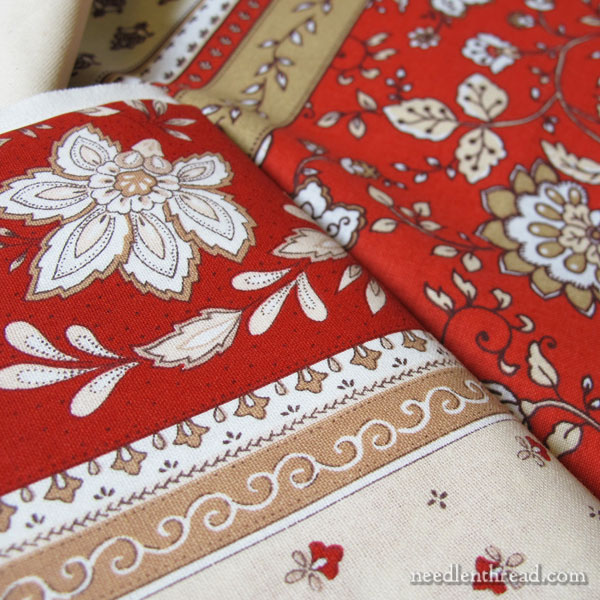
If whatever you’re making also has a cotton lining (mine does), it’s a good idea to wash the lining fabric, too.
Now, if you never plan to launder the thing you’re making, do you have to wash the fabrics and get the shrink out? Not necessarily! But I always prefer to be safe rather than sorry, especially if I’m putting any time into a project.
Oh, Fabric Grain!
Incidentally, the diagonal weave of the twill might be somewhat deceiving when it comes to cutting the fabric on the grain.
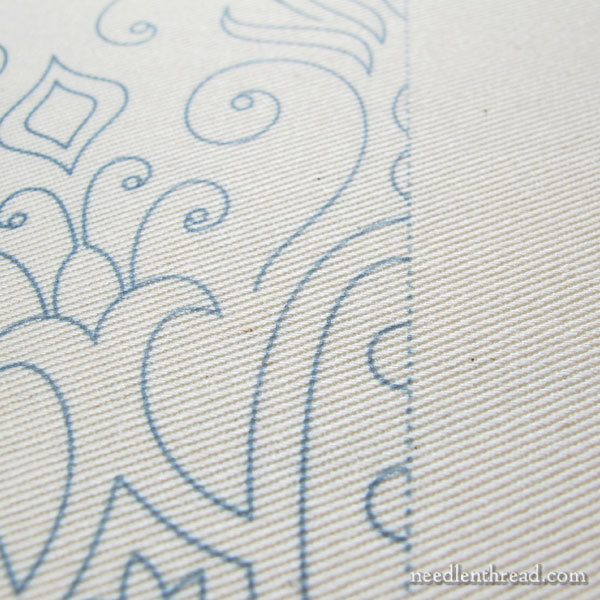
Despite the fact that the twill is a diagonal weave, it should still be cut on the grain. If you’re embroidering on the twill, then, you’ll have to make sure you transfer your design aligned with the grain. If it’s off at all, you’ll end up having to cut your embroidered pieces slightly on the bias, and that could cause problems with construction.
If you’re not sure what I mean by “on the grain” or “on the bias,” this article about cutting fabric on the grain will explain.
To avoid transferring the design on the bias on the twill, I line the design up with the selvage, or edge, of the fabric. Otherwise, the diagonal weave throws me off and I can’t quite be sure I’m getting the design transfer straight.
I transferred my design twice, because one of them ended up a bit cattywampus.
For some reason, the diagonal weave in twill plays with eyes, and I have a hard time seeing beyond the diagonal ribs. When I step back away from the twill, it isn’t as noticeable, but when I’m stitching and really focusing on the fabric, I see the diagonal lines almost more than I see my stitching. They give me a bit of vertigo – kind of like looking at houndstooth designs or small black and white checked fabric. I go googly-eyed! Once I get used to it, though, it isn’t bad. This is one of the reasons I usually opt for the lightest weight twill I can find, if I need linen twill for embroidery. The heavier the twill, the more pronounced the diagonal ribs, and the more my eyes are mesmerized by them. I’m pretty sure this is just a personal thing.
So that’s where I am with Twill and Duck. Next time we visit this slowly-developing project, I’ll show you some of the stitching on the twill and discuss any foibles along the way!
Favorite Kaleidoscopes Pattern Collection
If you’d like to stitch up your own version of Party in Provence, which is the pattern I’m using in this project, you’ll find the pattern available in my Favorite Kaleidoscopes collection – over 30 kaleidoscope designs for hand embroidery and other crafts.
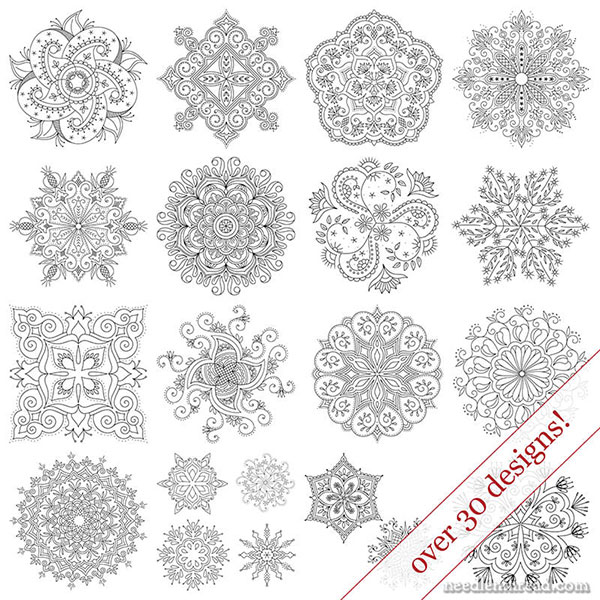
You’ll also find the pattern for Birthday Bash and Tulip Festival in the same collection!
The kaleidoscope designs range from small 4″ designs to large 8″ designs, from simple to complex. You can read about the collection in detail here, or jump straight over to my shop to grab your own copy!







Hi Mary!
I’m so glad you decided on red and tan – my favourites! Very French…this is going to be so pretty!
I, too, get all google eyed when using twill, so you’re not alone.
Liebe Grüße,
Kathy
Thanks, Kathy! I like the colors, too. It was a though decision between these and blue and yellow. The lining cotton is from Provençe – it’s a look I love – and since I had it, I thought I’d go with it!
Hi Mary,
I can’t wait to see how the duck comes out. I bought some once in lieu of trigger (which I couldn’t find) and after it was washed, it was wrinkled and stiff as a board and deemed unusable… for anything! I don’t know what happened to that piece of duck, but if it shows up again in the fabric stash, I’ll try to do SOMETHING with it, though probably not embroidery.
Let me know if it’s hard on your hands when you work with it, ok? Thanks for all the info you provide for us!
Hi, Marty – I should have clarified! I’m not stitching on the duck! Sorry! :-/ I’m only stitching on the twill. However, that said, there are different weights of duck – if you get a lighter weight duck, wash it, and then only partially dry it, then iron it while still damp, you should come out wrinkle free. At that point, it’s ready to stitch on. Whether or not I’d mount it in a hoop is another question. I’d probably use a frame, so that I don’t have to re-rinse and re-iron.
Hi Mary,
Love the colours and learning about a project using non-traditional embroidery fabric. Curious about how you transferred the pattern, it looks so crisp and perfect. Is it iron on?
Thanks, Sarah
Thanks, Sarah! Yes, it is. Much faster! To make your own iron-ons at home, I highly recommend Sublime Stitching’s fine-tipped iron-on transfer pens. You can find them reviewed here: https://needlenthread.wpengine.com/2015/05/sublime-stitching-iron-on-transfer-pens-review.html I prefer the blue.
Dear Mary
What a lovely choice the red and tan and flower pattern for the lining sounds wonderful and I really like the thread colours you have chosen and I really like the flowered inside fabric it’s going to be so lovely. I really look forward to the progress on this project how exciting and unusual for you. I’m embarking at the moment on a felt quiet book for my niece who is pregnant making all sorts of felt images such as farm house, clock, solar system, puzzle, cheese and mouse, rainbow but its the hardest project I have ever attempted, but it gets the old grey creative cells going. Thanks for sharing you tote bag project with us and for the photos can’t wait for you to start.
Regards Anita Simmance
I love the pattern you’re showing on this page. Is that what you’re using for your bag or is it a different one. Would sure LOVE to see that pattern. Thanks for all the information, tutorials, and beautiful projects on your website. I look forward to each of your emails.
http://www.bigduckcanvas.com/
One day I embarked on a similar project, except I was making tote bags for my farm veges. I found the above company. Often they have a closeout fabric that may be a second, but is still pretty terrific. I got 10 yards of heavy 12 oz hemp. It had a stain on one edge, which I was able to get out by boiling in oxyclean. I dyed some of it another color and the stain worked perfectly into my design. I love embroidering on this fabric. I have found that both sharp and blunt needles work on it.
They have some cotton linen blends that are pretty neat. I have never been as satisfied buying fabric on the internet. They send samples and are easy to work with. I’ve called on the phone and gotten help planning and ordering fabric for a big project. Their duck is the best price I have found. I like that they tell you the percentages of the fabric composition and the weight, so you can figure out quickly what you need. In my case, I don’t like stitching on anything with poly, so I can skip through those when I’m hunting fabric.
My bags turned out too good. People who got farm produce want to keep them! Love to see how your project turns out. That red fabric is beautiful.
I know just what you mean about the pattern having a wierd affect on you, Mary! I once had a skirt in a houndstooth pattern, and had to give up pressing it as I couldn’t look straight at it! Wearing it was ok, as the angle of view was different!
Hello Mary!
I have enjoyed reading your inspirational posts for several years now. Unfortunately, I have not found the time to do much embroidery! I am, however, a hand weaver and have found your recent posts on linen and twill very interesting. I had no idea that linen twill was traditional for crewel embroidery. For those not familiar with weaving, twill is woven by skipping warp threads (over 2 under 2 or over 1 under 3). The weave looks diagonal because the pattern of skipped threads shifts over each row of weaving. This makes for a very flexible, strong fabric and also allows the weaver to create fabric with 2 tones (notice how the front and back of denim are two shades of blue). I was just wondering if the twill linen used for crewel embroidery is a single color, or if it is woven with multiple shades as is common when hand weaving heirloom linens?
I’m so glad you mentioned the ‘pattern vertigo’ you get – I thought I was the only one! I’ve never stitched on twill but I can see that the heavier weights might be a problem. I have trouble with the striped or patterned floors that they sometimes have at airports, libraries etc. – I have to look away to avoid vertigo and nausea.
I really like the colours and prints for this project! Look forward to seeing it progress.
I’ve embroidered on both cotton twill and duck. I do not recommend the duck – it stays stiff and hard no matter what. The twill was very easy to stitch on because although it’s a densely woven fabric the component threads are very fine. Some of the unbleached cotton twill in my (inherited) stash has a slight surface fuzz, making it hard to get crisp lines when you draw on the design, but some other pieces are beautifully smooth. Hard laundering helps improve the hand.
You picked a great color combination Mary! Just in case your design is still a work in progress, have you considered including Broderie Perse? The fabrics you selected have some larger motifs that would lend themselves to this technique. BP wasn’t always appliqué on plain ground. Sometimes it was used to further embellish a floral ground with added motifs & texture. Chintz is not necessarily a requirement. Just a thought…
Love the expression cattywampus! I hae never heard it before but can guess what it means.
Cant wait for the rest of this …..
Best wishes and many thanks for your amazing teaching
And note that neither canvas nor duck should be confused with the canvasback duck, which is a type of waterfowl. 😉
Dear Mary, I have just started a basic crewel course with the Embroidery Association of Canada. I feel I’m kind of in over my head and your site is invaluable. The timing for this kind of information simply could not be better! I am supposed to do a little research and I find myself popping down all sorts of rabbit holes ending up in Worstead England in the 12th century or pondering grains – and there you are – explaining it all very nicely. Thank you, April
I love embroidering bags, so I really want to know about your ‘Masterpiece Tote’
Hi Mary !
What kind of cotton duck fabric is the best to embroider ? ( for long and short stitch)
lightweight ( 4 – 5 Oz ), Medium ( 7- 8 Oz ) or Heavy ( 10 – 12 Oz )
Thanks !
Hi, Iris – I used about a medium weight duck, because I was making a tote bag. But it really depends on what you’re stitching, and what you intend to make out of it. If you can get swatches of different weights and test them to see what you like, that would probably be the best route to go, before putting a lot of time and money into the embroidery or supplies, just to find out you don’t like it. I’m to a huge fan of stitching on duck, personally, but I can definitely see doing it for totes and the like!
I would be absolutely lost without your blog. I am trying to buy less and upcycle what I have on hand and thrift the rest. I assumed there would be a magnificent blogger out there with info on how to identify appropriate fabrics for crewel. I collect kitsch and vintage patterns. This is the only place that sheds any light on choosing stitchable materials that will last. You are greatly appreciated!
Thanks, Boo! 🙂